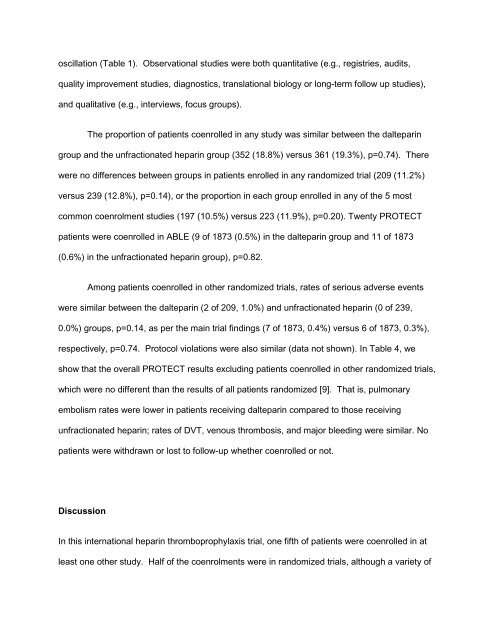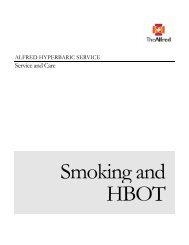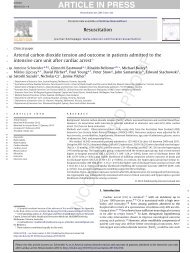Critical Care
See Full Article - Alfred Intensive Care Unit
See Full Article - Alfred Intensive Care Unit
- No tags were found...
You also want an ePaper? Increase the reach of your titles
YUMPU automatically turns print PDFs into web optimized ePapers that Google loves.
oscillation (Table 1). Observational studies were both quantitative (e.g., registries, audits,<br />
quality improvement studies, diagnostics, translational biology or long-term follow up studies),<br />
and qualitative (e.g., interviews, focus groups).<br />
The proportion of patients coenrolled in any study was similar between the dalteparin<br />
group and the unfractionated heparin group (352 (18.8%) versus 361 (19.3%), p=0.74). There<br />
were no differences between groups in patients enrolled in any randomized trial (209 (11.2%)<br />
versus 239 (12.8%), p=0.14), or the proportion in each group enrolled in any of the 5 most<br />
common coenrolment studies (197 (10.5%) versus 223 (11.9%), p=0.20). Twenty PROTECT<br />
patients were coenrolled in ABLE (9 of 1873 (0.5%) in the dalteparin group and 11 of 1873<br />
(0.6%) in the unfractionated heparin group), p=0.82.<br />
Among patients coenrolled in other randomized trials, rates of serious adverse events<br />
were similar between the dalteparin (2 of 209, 1.0%) and unfractionated heparin (0 of 239,<br />
0.0%) groups, p=0.14, as per the main trial findings (7 of 1873, 0.4%) versus 6 of 1873, 0.3%),<br />
respectively, p=0.74. Protocol violations were also similar (data not shown). In Table 4, we<br />
show that the overall PROTECT results excluding patients coenrolled in other randomized trials,<br />
which were no different than the results of all patients randomized [9]. That is, pulmonary<br />
embolism rates were lower in patients receiving dalteparin compared to those receiving<br />
unfractionated heparin; rates of DVT, venous thrombosis, and major bleeding were similar. No<br />
patients were withdrawn or lost to follow-up whether coenrolled or not.<br />
Discussion<br />
In this international heparin thromboprophylaxis trial, one fifth of patients were coenrolled in at<br />
least one other study. Half of the coenrolments were in randomized trials, although a variety of









